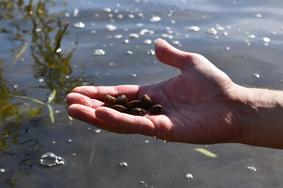|
Having trouble viewing this email? View it as a Web page.

|
|
|
Fresh from the Field is a weekly album showcasing transformative impacts made by grantees supported by the National Institute of Food and Agriculture.
Nov. 22, 2017
|
|
 A Message from Sonny
As you gather with family and friends to partake of the wonderful, bountiful food that we have, remember that it's the result of our amazing farmers and livestock producers. In America, unlike any other place on Earth, we have this incredible innovation engine -- the discoveries that you make, the knowledge that is translated and delivered to end-users, and the education that is delivered across the country by our land-grant partners. We, at the National Institute of Food and Agriculture, have the privilege of support you and your efforts. Thank you, and I wish you all a safe and happy Thanksgiving.
Dr. Sonny Ramaswamy, Director, National Institute of Food and Agriculture
Watch Sonny's video.
|
Success Stories

Are Petite Poplars the Future of Biofuels? UW Studies Say Yes
In the quest to produce affordable biofuels, poplar trees are one of the Pacific Northwest’s best bets - the trees are abundant, adaptable to many terrains, and their wood can be transformed into substances used in biofuel and high-value chemicals. The challenge is waiting of 10-20 years between harvest cycles.
Researchers at University of Washington, however, have found a way to cut to the chase: they're harvesting young poplars every 2-3 years while still using the same root systems. As juvenile trees, they can be planted closer together to get more product per acre and trimmed in a way (called "coppicing") that ensures most of the branches sprout up from the stump.
Leaves, bark, and stems from the young poplars are harvested and manufactured into bio oil and ethanol. Results have been published in two papers: ACS Sustainable Chemistry & Engineering and Biotechnology for Biofuels.
NIFA supports this project through the AFRI-funded Advanced Hardwood Biofuels Northwest project.
Read the full article in University of Washington News. Photo by Chang Dou, University of Washington.
|
 Highly Productive Corn has Reduced Ability to Adapt
Crop breeders must be able to develop new varieties that are adaptable to a new or changing growing conditions in the same area. But, does acclimating to particular locations change a plant's ability to adapt to new or stressful environments?
Researchers have concluded that the growers have produced corn varieties that are strong and stable, but are less flexible in their ability to respond to stresses. In addition, these corn populations may have a reduced ability to contribute to breeding programs that seek to create new varieties adapted to novel environments.
The University of Wisconsin-Madison-led Genomes to Fields project team includes University of Arizona, Colorado State University, South Dakota State University, University of Nebraska, Kansas State University, Texas A&M University, University of Minnesota, Iowa State University, University of Missouri, Arkansas State University, University of Illinois, Mississippi State University, Michigan State University, Purdue University, Ohio State University, University of Georgia, Cornell University, Penn State University, North Carolina State University, Clemson University, University of Georgia, University of Delaware, USDA's Agricultural Research Service, and Canada's University of Guelph.
The research team found that the regions of the corn genome that have undergone a high degree of selection - for example, gene regions that contribute to high yield in a particular location - but with a reduced capacity to respond in other environments. "When you try to adapt cultivars to many different environments, you end up with plants that are not great anywhere," said UW–Madison Professor of Agronomy Natalia de Leon. "The cost of maintaining this plasticity is at the detriment of maximum productivity."
NIFA supports the Genomes to Fields project through an AFRI grant.
Read the full article in Morning Ag Clips. Photo courtesy of cornbreeding.wisc.edu.
|
News Coverage

Auburn Develops Vaccine to Fight Costly Catfish Disease
Columnaris disease can affect nearly all freshwater fish species and causes millions of dollars in annual losses in the catfish industry alone. The one columnaris vaccine currently available is only moderately effective, but researchers at Auburn University have been working on an improved immunization using bacteria derived from a highly virulent strain of the disease.
Auburn will use a NIFA grant to field-test the novel vaccine, which may effectively and economically control the disease. To date, the Auburn vaccine has outperformed the commercial vaccine in all experiments conducted, reducing cumulative mortality two to four times better than the existing vaccine.
NIFA supported the program through an Aquaculture Research Program grant.
Read the full article in Feedstuffs. Photo courtesy of Auburn University.
|
The Library

eDNA Tool Detects Invasive Clams Before They Become a Nuisance
Early detection is the key to controlling or eliminating invasive species, and now a research team is using a new tool to do just that. The University of Illinois-led team of Rice University, University of Notre Dame, and University of Nevada at Reno used environmental DNA (eDNA) to detect invasive clams in California and Nevada lakes.
The team developed an eDNA assay to test for the presence of Corbicula, an invasive freshwater clam. Though small, the clams can have major effects on fresh water. They can clog pipes and damage infrastructure, similar to the impacts of zebra and quagga mussels in the Great Lakes region. Corbicula also affect water quality and contribute to the growth of nearshore algae.
NIFA supports this project through Hatch funding.
Read the article at the journal Management of Biological Invasions. Photo courtesy of University of Illinois.
|
Video
 Keeping an Eye on Hydrologic Change in the Northern Hardwood Forest
Forests in the Northeast provide hydrologic benefits, including clean and reliable drinking water, flood control, and regulation of stream flow. Changing weather patterns are increasing the frequency and intensity of rainfall events, including both intense storms and droughts. Researchers at the University of New Hampshire are studying the impacts of climate variability and altered rainfall patterns on forest health, productivity, and hydrology. The results will provide the information needed to make effective decisions for ensuring the sustainability of forests and water resources.
NIFA supports this project with a McIntire-Stennis grant.
Watch the video of researchers monitoring the 900-square-meter canopy of gutters that channel 50 percent of rainfall away from the trees beneath it.
|
Tweet of the Week
#NIFAIMPACTS
|
|

NIFA’s mission is to invest in and advance agricultural research, education, and extension that solve societal challenges. NIFA’s investments in transformative science directly support the long-term prosperity and global preeminence of U.S. agriculture. To learn more about NIFA’s impact on agricultural sciences, visit www.nifa.usda.gov/Impacts, sign up for email updates or follow us on Twitter @USDA_NIFA, #NIFAImpacts.
Editor: Falita Liles
USDA is an equal opportunity lender, provider, and employer.
|
|
|
|